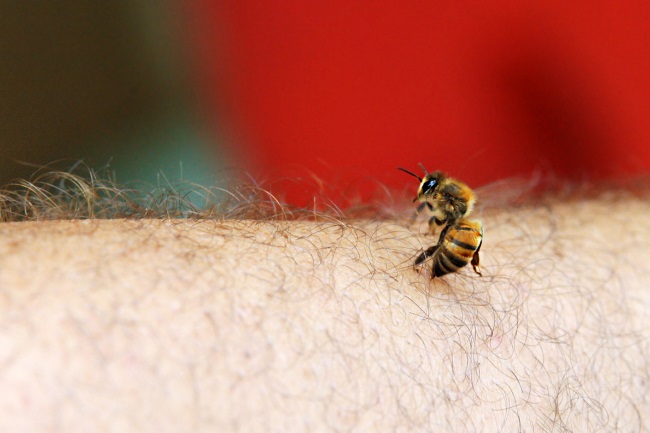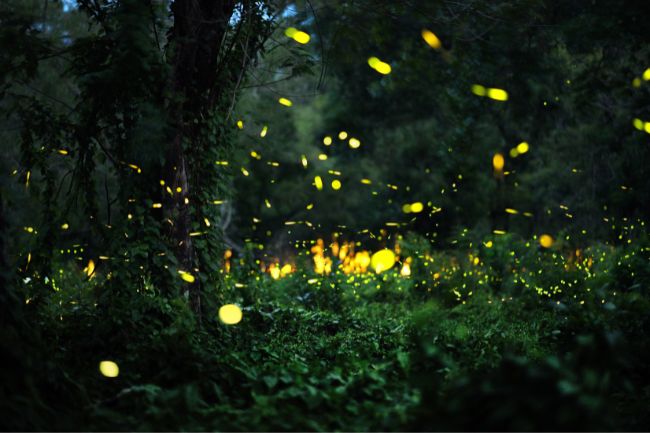Fireflies do not sting or bite, instead, they use their wonderful luminescence to warn potential predators that they are toxic to eat. This tactic is known as warning colouration and is common within the insect world.
Contents
What is a sting?

It’s not uncommon for stings and bites to be confused for one another. A bite is carried out by an animal using its mouth, teeth and possibly fangs, to inflict harm to another animal, often as part of an attempt to kill it for food.
A sting by contrast is a separate appendage, usually located at the end of the abdomen in insects, or the tail in fish. Stings are usually long, hard needle-like appendages, that are generally hollow, allowing the animal to pump poisons into the body of the creature they have stung.
Examples of animals with stings include bees, stingrays and jellyfish.
Also read: Why do Bees Sting? What Happens After? (Explained)
How do fireflies defend themselves?

Fireflies do not possess a stinger or have fangs as a means of defence. Instead, they use their brilliant display to warn predators to leave them well alone.
This tactic is known as warning colouration and is very common in the animal world. Bees and wasps use bright colours and striking patterns to warn animals that might otherwise want to eat them that they come with a sting in the tail.
| Firefly Species | Defense Mechanism |
|---|---|
| Photinus pyralis | No stinging or biting behavior |
| Photuris versicolor | Mimics toxic firefly species |
| Pyractomena borealis | Emits defensive chemicals when threatened |
| Lucidota atra | Produces bitter-tasting chemicals |
Another common use of warning colouration is utilised by animals who have no external defence mechanisms, but are themselves poisonous to eat. This is particularly common amongst insects, who are often too small to cause any actual harm to larger predators. However, those species that make themselves unpleasant to eat have the chance of taking themselves off the menu.
Common warning colourations are usually bright colours, such as red, yellows and oranges, often paired with contrasting colours such as black. However, fireflies have gone for an altogether different tactic, choosing to utilise bioluminescence instead.
Bioluminescence is the ability of some plants and animals to use chemical reactions within their bodies to create light. Many lifeforms use bioluminescence for different purposes, from defence to attracting a mate.

Within fireflies, it’s thought bioluminescence evolved within the larvae, and was utilised to warn predators that they were poisonous to eat. Few predators can stomach the toxins within the bodies of the fireflies, meaning that once an animal has eaten them once, they aren’t likely to want to repeat the experience. This means that while a few fireflies may die, overall the species will thrive.
Today, different species of fireflies have utilised their ability to glow at different stages of their lives and for different purposes. Some glow both as adults and juveniles and others just as juveniles. In adults, the primary purpose is to attract a mate, though it is also likely that predators take their glow as a warning as well.
Even stranger, some fireflies have lost their ability to glow. In this case, it may be that they opted for a much subtler form of defence, hiding away from detection rather than warning predators to leave them be.
Also read: Firefly Larvae: Do They Glow, How do They Live & More
Are they dangerous to humans?
Fireflies are incredibly docile creatures, not stinging or biting humans. As with all toxic animals, the only harm they can do to humans is if a person decides to eat one. However, this is an unlikely thing for anyone to choose to do. And as their toxins are designed for much smaller animals, it’s doubtful they would cause any real harm to a human unless eaten in large quantities.
| Behavior | Interaction with Humans |
|---|---|
| Flashing patterns | Fireflies use bioluminescence for mating and communication, not for stinging or biting humans |
| Attraction to light | Fireflies are attracted to artificial lights but do not harm humans |
| Gentle handling | Fireflies are delicate and should be handled with care to avoid injury, but they do not sting or bite |
Are they dangerous to pets?

As fireflies do not sting or bite, the only harm they are likely to occasion is if your pet ate one. Luckily, because they are so unpleasant tasting, it is likely that your pet would choose to spit them out, rather than swallow them.
Also read: What Eats Fireflies? (Its Natural Predators)
Fireflies, friend or foe?
While many of us may panic when we find out an insect or animal contains toxic chemicals, it’s worth remembering that these creatures are often harmless unless deliberately consumed. For those that have chosen the avenue of warning colouration to scare off their predators, because of the toxins they contain, there’s little point in wasting their energies on other defence tactics such as stingers and fangs.
| Misconception | Explanation |
|---|---|
| Fireflies are insects that sting like bees or wasps | Fireflies do not possess stingers and do not sting |
| Fireflies are harmful to humans | Fireflies are harmless and beneficial insects that do not pose a threat to humans |
Fireflies in particular are very gentle and unobtrusive creatures. And while we may enjoy their brilliant displays, these lights aren’t even aimed at us. A firefly is expending its energy letting all the surrounding, bats, birds and small mammals, know that it’s just not a pleasant snack for them. And while it may not be a pleasant snack for us humans either, at least we get some of the most magical displays on Earth from this little insect’s peculiar method of self-defence.

